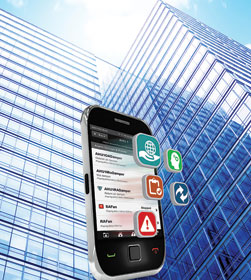

Building management systems (BMS) have been around for many years in one form or another. In the IT world we see what the security and facilities managers know as BMS is used to control data centres, from ensuring the temperature remains constant, electricity supply is not disrupted and other access control and security functionality works as required.
Traditional BMS, on the other hand, is a set of applications that allow for the full control of a building or set of buildings to ensure optimal performance of all the components, which will result in benefits such as energy savings and effective maintenance over the long term. In its early versions, BMS were complex monsters that required specialist skills for every feature they possessed; today, however, BMS are easier to use and they make integrating with third-party applications easier to allow for full control of building management services and the associated cost benefits.
What are BMS systems doing to keep up with the real world today? Today, you can’t sneeze without someone coming up with a mobile app for hay fever. We are also seeing a significant demand for integration skills in the security market, which means a BMS system can’t try to be the only player on the block. What are these complex systems doing to facilitate integration with products from multiple vendors? Hi-Tech Security Solutions asked a couple of BMS vendors for their thoughts on the current state of building management systems and what they will be doing in the future.
Hi-Tech Security Solutions: What are the latest trends in BMS you are seeing in the market?

Richard Creighton, Honeywell Building Solutions, business leader, Africa: Mobility is a big trend we are seeing. Our facility managers today need to be free to move across their facilities, between buildings at a moment’s notice, yet need to still be able to monitor and control their facility. Being able to troubleshoot via a smartphone or tablet device presents great advantages for productivity and operational improvements for all types of facilities.

Neil Cameron, general manager, systems & service, Africa, Johnson Controls: BMS today are about collecting and collating information about a building or campus and make it as accessible as possible to people who require the data. Johnson Controls is also putting this information in the cloud so that the appropriate people can access it anywhere on any device. What’s more, we also want people to be able to compare their BMS functionality and behaviour to other companies, be it in the same field or even competitors, which are also stored in the cloud, to ensure they gain the most from their systems. Of course, this is done without compromising anyone’s data.
As such, BMS are getting less about technology and more information driven – you can’t use technical data, but you can do a lot with information.
There is also a drive to connect BMS to different systems. The traditional core of HVAC and so forth is still central, but today we see this growing to cover additional applications such as surveillance, access, perimeter, irrigation, energy meters, IP telephone systems, UPS and generator control etc. Almost anything on your TCP/IP network can be integrated.
Hi-Tech Security Solutions: Are companies using BMS systems to their full capacity or merely installing parts of them, such as energy management applications?
Richard Creighton: Most value can be derived when integrating solutions due to the power of facility-wide data to optimise performance and make more informed decisions. We see more than 50% of our projects are only used for metering functions, while 10% of projects will use energy management applications. This is mainly because of the complexity of the system.
Neil Cameron: There are always exceptional cases where companies use their BMS to its fullest capacity, but overall we find that most customers don’t use all the functionality available to them. This is somewhat disappointing as the BMS are full systems and all the functionality is there – very few vendors sell stand-alone functionality.
The reason we see for not using all the functionality is that there is a lack of skills in most companies to use the systems to their fullest. There seems to be a focus on specific skills in facilities management, so we have the 'aircon guy' or the electrician who do what they are trained to do and don’t go beyond that. So we generally see customers using HVAC and maybe a bit more, but not all the features they have in the system.
Hi-Tech Security Solutions: Are BMS developers committed to open systems to allow customers and integrators to integrate other solutions into the overall BMS system? Are there common protocols to facilitate easier communications and integration?
Richard Creighton: Honeywell is an advocate for an open systems approach as we realise the value that can be realised from integration. Our signature integration platform, Honeywell Enterprise Buildings Integrator (EBI), communicates with industry-leading open system protocols such as HTML, LonWorks, BACnet, OPC, ODBC and ONVIF. The ability to integrate with third-party software and hardware promotes interoperability and offers freedom of choice, scalability and long-term flexibility, which is valuable for our customers. Looking beyond facility systems, EBI also integrates with core business systems, such as human resources or payroll, for intelligent automation of business processes and enhanced strategic control of a facility.
For easier integration of processes in a facility, EBI contains a rules-based Automation Engine. The new Automation Engine functionality is event-based and simplifies the automation of routine integration tasks, and reduces the need to write complex, time-consuming scripts. Facility-wide rules, such as activating a camera recording when an incident occurs can be configured in minutes. Integration is made easier, enabling you to realise the benefits of intelligent automation driving operational efficiencies.
Honeywell is also employing Enterprise Web Services (EWS) in EBI to achieve real-time, open communication between critical systems through rapid application and interface development. Integration of specialised subsystems, such as perimeter intrusion detection or service maintenance systems typically becomes simpler and faster, and EWS makes it easier to develop custom applications to meet the unique requirements of a facility.
Neil Cameron: Most BMS systems are well developed so there are a variety of open protocols available that are built into most systems, such as BACNet, Modbus, LonWorks and more. In keeping with IT trends, most of the protocols have evolved into auto-detect protocols so that there is no need to write drivers to integrate systems. Most of the time it is quite simple to get them talking to each other.
It is harder on the security side when integrating as the BMS philosophy is to make as much useful information as possible available and to visualise it in an easy-to-understand manner. In the security world, people don’t want to share information as easily as most systems are closed and encrypted (for the right reasons). The work to provide security information to the BMS is therefore significant as there is a need for privacy and security that outweighs the desire to make everything possible available.
Hi-Tech Security Solutions: Do or will customers have the option to pick and choose applications they want and integrate them into their BMS? Is this a realistic option?
Richard Creighton: Though we stand by Honeywell solutions, we acknowledge that our customers may have legacy systems which they need to integrate, or perhaps a specialised industry related system, which they need to integrate with their BMS. Our integration platform, EBI, is open and our engineers are world-class and accustomed to custom integrations.
Neil Cameron: As noted, most BMS systems have a variety of modules built into them and it’s primarily a matter of using them. We don’t see many customers adding more systems onto a BMS since they are probably already there, and there is also the question of licensing and cost when bringing in a new application.
Hi-Tech Security Solutions: What about accessibility? Today the trend is to make mobile apps for everything, are BMS systems accessible from smartphones to allow operations and facilities managers to control their buildings remotely?
Richard Creighton: Mobility is a big trend, as mentioned above. Our EBI solution can be operated from either a smartphone or tablet device, which makes managing a facility much easier.
Neil Cameron: It’s getting easier all the time. As little as five years ago, a BMS was a proprietary system with proprietary software and databases, and customers paid per server or via some other form of licence. It was definitely not user friendly in terms of accessing and understanding the information collected. Today things have been simplified and it is easy to use as well as to get to the information on almost any device – and the information can be stored in the cloud.
There are, of course, still specific applications for specific areas that are not included in the broader BMS systems, but these can easily be integrated. An example is a Johnson’s Control customer that has done away with light switches as part of its installation. Each room has a barcode on the wall; when entering the room, the user scans the barcode with a mobile device and is taken to the company website where different environmental settings can be set.
Hi-Tech Security Solutions: What new developments can people expect from your BMS offering in the next year or so?
Richard Creighton: The Honeywell technology roadmap is extensive. On the horizon, we have new dashboards for energy and security, enabling easier accessibility of information for faster decision-making and exciting enhancements around user experience such as touch screen technology (which we can’t yet reveal).
Neil Cameron: BMS are becoming more modern and more fun to use. We will see systems that are easier to setup and require less knowledge and experience on how to connect the systems in your building and less requirement to write software. We can expect BMS to automatically detect the components they are supposed to manage as soon as they are installed. The system will pop up a screen asking if you want to connect and manage a new installation, and then set it up according to predefined standards.
I also expect to see more use being made of wireless systems to avoid the hassles of laying cables. This will accompany the move to incorporating the management of more systems, such as IP telephones etc. As noted, almost anything on a TCP/IP network can be included.
And finally, we expect to see a greater focus on presenting information graphically to provide an easily understandable overview of the status of systems at a glance, as well as the benefits delivered.
| Tel: | +27 11 543 5800 |
| Email: | [email protected] |
| www: | www.technews.co.za |
| Articles: | More information and articles about Technews Publishing |

© Technews Publishing (Pty) Ltd. | All Rights Reserved.